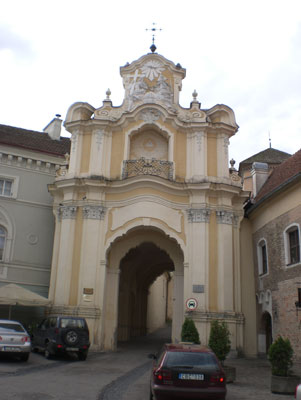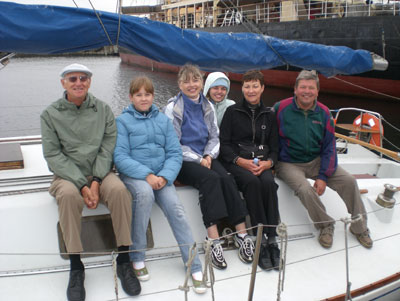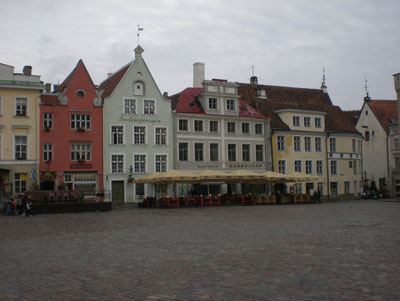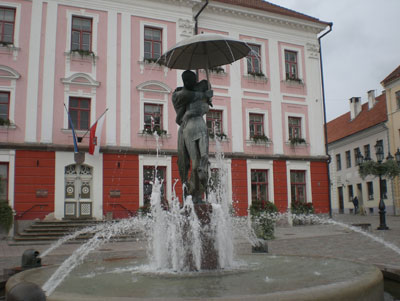Touring the Baltic states of Estonia, Latvia and Lithuania
by Charles and Nita Swartz, Las Cruces, NM
My wife, Nita, had always wanted to visit the Baltic states of Estonia, Latvia and Lithuania. We searched for tours of those countries but never found one that visited all of the places in which we were interested.
A mathematician friend of mine does joint work with a colleague at the at University of Tartu in Estonia, so I asked him if he knew of any travel agencies there. His friend recommended Hansa Travel in Tallinn, and what a great find that turned out to be!
We e-mailed Hansa Travel and outlined the places we were interested in visiting. Helen Allikmäe responded quickly and informed us that driving in the Baltics is easy. She suggested that if would be our best option and gave us a preliminary itinerary.
After making several alterations, we agreed on a 16-day itinerary and a price. Helen booked all the hotels, each of which included a wonderful breakfast, as well as walking tours at each major stop and a mid-size car with a TomTom navigation system.
Starting in Estonia
Upon our arrival at the Tallinn Airport on Sept. 4, 2008, we were met by Helen and her mother, Margi Allikmäe.
Hansa Travel is a small, family travel agency run by Margi. They usually arrange trips through the Baltics for groups, typically for travelers from Germany or Scandinavia, but also arrange trips for individuals. We were the first Americans for whom Hansa had arranged a tour.
After welcoming us to their country, Margi and Helen took us to the Nordic Hotel Forum for our 3-night stay. Helen ordered tea for us and went through the itinerary of the trip, giving us the vouchers — in perfect order — for each hotel and ferry transport. Also included was a packet with maps and tourist information for each place we were to visit.
They then took us for a short stroll through Tallinn’s Old Town, one of the best-preserved medieval cities in Northern Europe, and gave us ideas for places to eat and museums to visit.
For the morning of our second day, Helen had scheduled a guided walk through the Old Town which covered some history of Estonia and Tallinn. We found it to be very informative.
We were also supplied with a Tallinn Card, which covered all public transportation and entry to the city’s museums for a 24-hour period. We used this card to visit Kadriorg, famed for its lush green seaside district with the imperial Baroque palace built by Peter the Great.
We also used the card to visit the Open Air Museum, where most of Estonia’s oldest wooden structures — mainly farmhouses but also a chapel (1699) and windmill — are preserved.
Kuressaare
Following a day of our cruising around the harbor with Margi and her family on her father’s sailboat, our rental car was delivered to the hotel. We set out in the morning for the small city of Kuressaare on the island of Saaremaa.
It was an 1½-hour drive to the ferry which took us to Saaremaa (a half-hour ferry ride), then another 1½-hour drive to Kuressaare.
Our small hotel, Arensburg Boutique Hotel & Spa, served a wonderful breakfast and had a sauna and heated pool, free for its residents, with massages available on site for a fee.
With a magnificent 13th-century castle rising up in its midst, Kuressaare is a picturesque town with peaceful streets, beaches, parks, charming guest houses, cafés and spas. Both the beach and the park have great walking paths, which, unfortunately, we made limited use of due to the cold, rainy weather.
We did discover a wonderful small restaurant, thanks to a resident I met in one of the local shops. Restaurant Öuemaja (Uus tänav 20A) is located in an old house that was once the home of noted writer and linguist Johannes Aavik. We each had a wonderful schnitzel, a salad plate with various vegetables and wine for approximately $30 — a real bargain.
On to Latvia
After two nights in Kuressaare we drove to Riga, with a stop in Pärnu, Estonia, a small university city. Pärnu had a very nice city center with several small museums and churches.
By chance, we walked into one of the great bargains on our trip at the restaurant Edelweiss (Kuninga 15); following the locals for lunch is not a bad thing to do. We had a wonderful fish soup, loaded with fresh salmon and vegetables. With condiments and bread, bottled water and tea, for two people our bill was approximately $6.
We drove on to Riga, where we found our small hotel, Boutique Hotel Ainavas, in the center of Old Town. This hotel offered the best breakfast we had on our trip. Every morning we had the choice of omelets or crêpes — both spectacular — in addition to cereal, fruit, cheese and a variety of meat. The staff was very accommodating and pleased that we had selected their hotel.
In the morning we first visited the local market, which was easily the largest and most spectacular market we have ever seen in Europe. The weather was cold and rainy, so Nita bought a pair of hand-knitted wool mittens, which she didn’t take off for the rest of the trip.
Later we took a guided walking tour which highlighted the history of Riga. We went to the Museum of the Occupation, where displays described the perils of the Latvian people under both the Nazi and Soviet occupations. It was a very sobering experience and one that should not be missed.
Riga is the largest city in the Baltics, and it has a fairyland Old Town area with an interesting mix of 17th-century and Art Nouveau architectural styles. To do justice to its bustling arts center and museums, it deserves an extended stay.
Lithuania
We left Riga and drove on to Lithuania. Our first stop was at the Hill of Crosses near Šiauliai, where thousands upon thousands of crosses on a hillock have inspired countless pilgrimages.
Crosses first appeared there in the 14th century, multiplying after a bloody anti-czarist uprising to become a potent symbol of suffering and hope. The site was destroyed many times during the Soviet era, but the pilgrims kept coming to commemorate the thousands of people who had been killed or deported. It is a simple place to visit but stirs tremendous feeling.
We then proceeded to the small, very picturesque city of Palanga, home to an amber museum, and continued to Klaipe˙da for a one-night stay at Hotel Euterpe. After Klaipe˙da was destroyed in WWII it was rebuilt and repopulated, developing into an important city for shipbuilding and fishing.
We took a short ferry ride the next morning, then drove to the small resort town of Nida on the Curonian Spit. Nida offers varied attractions plus hiking trails, bike paths and beaches. It is a peaceful and pretty village situated at the end of the peninsula, with the Baltic Sea on one side and a lagoon on the other. It is a truly unique place to visit.
Unfortunately, the weather was once again cold and windy.
On the ferry we saw a number of people carrying small plastic buckets and wearing rubber boots. On our return back to Klaipe˙da we saw that the buckets were filled with mushrooms that had been gathered in the forest on the island.
Toward Vilnius
We drove on to Kaunas, the second-largest city in Lithuania and at one time the capital. We stayed at Hotel Klaipe˙da, near a large square, with two churches and the city’s Old Town nearby.
The Old Town had some fine architecture and plenty of museums, but many of the buildings seemed in dire need of restoration, and graffiti appeared to be running rampant. There was a nice, small park surrounding the old presidential palace.
The city also prides itself in its wonderful market, which stretches along one of the major streets and borders a beautiful park.
Leaving Kaunas, we drove toward Vilnius, stopping at Trakai on the way. The centerpiece of Trakai is its picture-postcard Island Castle on Lake Galvé. The beautifully restored red-brick Gothic castle dates from around 1400. A footbridge links it to the shore, and a moat separates the outer courtyard from the main tower, with its central court, and a range of galleries, halls and rooms and the Trakai History Museum.
After checking in at Hotel Ambassador in Vilnius, we took a walk to Cathedral Square and Old Town. Hotel Ambassador was not a favorite for us; we would have selected another hotel, though the location was great.
The following day we took a walking tour, which again took us through Old Town but also covered many areas we hadn’t seen and explained some of the history of Vilnius and Lithuania. One of Europe’s largest preserved Old Towns, dating back to the 13th century, it has been declared a World Heritage Site by Unesco.
The guide also pointed out many interesting museums for us to return to, including an amber museum which was quite interesting.
The return trip
In the morning we started the long drive back to Estonia. The first night, we stayed at a small resort hotel, Hotel Baltvilla, located in Baltezers, Latvia, a small village on a small beautiful lake near Riga. This meant we did not have to drive through the terrible traffic of Riga.
As we continued on, we stopped to tour the Rundale Palace & Museum, a “must see” in Latvia. The palace is located near the small town of Pilsrundale, 12 kilometers west of Bauska.
This lavish creation is a monument to Latvia’s aristocratic ostentatiousness. It is a beautifully restored, enormous palace with very impressive gardens. A stroll through the gardens was a pleasant way to end our visit.
On our way to Tartu, Estonia, we stopped in Sigulda, Latvia. This small city and the surrounding area have a string of medieval castles. We visited the castle remains of the Livonian Knights’ stronghold, built between 1107 and 1126, first. The castle hasn’t been repaired since the Great Northern War (1700s), but its ruins are perhaps more evocative because of that.
The centerpiece of Sigulda’s Turaida Museum Reserve is Turaida Castle, which means “God’s Garden” in ancient Livonian. This red-brick archbishop’s castle, founded in 1214, was blown up when lightning struck gunpowder stored there in the 18th century. It was later restored.
There is much to see in this area, though the castles are widely separated. After lunch in Sigulda we drove on to Tartu.
Back in Estonia
Tartu is a small university town with a beautifully rebuilt center of classically designed 18th-century buildings bordering a river with adjacent parks. After checking into Hotel Dorpat, near the city center, we walked through Old Town and had dinner.
Returning to Old Town in the morning, we visited the river parks and the beautiful university botanical gardens, which nurture 6,500 species of plants and a large collection of palm trees in its giant greenhouse. A wander through the grounds was both pleasant and free.
North of the university stands the magnificent St. John’s Church. Dating back to 1323, it is unique for its rare terra-cotta sculptures which sit in niches around the main portal.
Finally, we headed for the end of the road, back to Tallinn. On the way we stopped in Po˜ltsamaa, where we visited the information center located inside a walled compound. (I might add, this information center was one of Estonia’s friendliest and was a pleasure to visit.) Once inside the walls, we discovered the ruins of a 1770 castle; it had been badly damaged in 1941 when the Nazis invaded, leaving a reminder to all.
The 17th-century church is generally locked, but the lady in the information center opened the church and gave us a tour. She explained that the local priest had somehow managed to obtain funds and had the church restored during Soviet occupation — an amazing feat.
The church boasts one of Estonia’s most magnificent organs, which had been out of commission until 2004. Concerts are held there throughout the year.
Also inside the castle walls is the town museum, which has photos of the original castle and information about the history of Po˜ltsamaa.
Our last stop, in Tallinn, was Hotel Ülemiste, located about 300 meters from the airport. Once again our efficient travel agent Helen had taken care of us, arranging for the rental car company to pick up our car at the hotel.
Margi, Helen and Helen’s boyfriend, Mart, met us at the hotel and inquired about our trip; they were especially interested in any problems that might have occurred with our hotels along the way. After catching up, they drove us to Old Town Tallinn, where we strolled for one last time through the medieval courtyards and cobbled streets and had a delicious dinner in the square.
The next morning we walked the 300 meters to the airport terminal and headed to Barcelona for another adventure.
The details
It was very easy to move from one country to another. We were stopped for passport checks on only two occasions, and all individuals in charge were friendly and helpful. One minor annoyance was that each country had a separate currency; however, there were numerous ATMs.
As Helen had suggested, driving in the Baltics was not difficult. The TomTom navigation system was a great help in the larger cities. Although “Tom” had some difficulties on short one-way streets, all in all he did a great job.
The only difficulty was passing on 2-lane roads, where the center of the road seemed to be the passing lane. We had to move to the side to let any oncoming car pass.
The cost of our trip was $1,960, which included all hotel bills and breakfasts, ferry tickets, the Tallinn Card, the Riga Card and the walking tours. The car rental was an additional E468. The Baltics seem to have a very elaborate bus system, so if you are not interested in driving, bus travel may be a possible alternative.
Hansa Travel (phone +372 6009933, www.hansatravel.ee) and Helen Allikmäe did a fantastic job of organizing our trip. E-mail Helen (info@hansa travel.ee) to arrange a wonderful trip to the Baltic states and meet our new friends.
We will be happy to answer any questions regarding our trip. Contact us c/o ITN.






